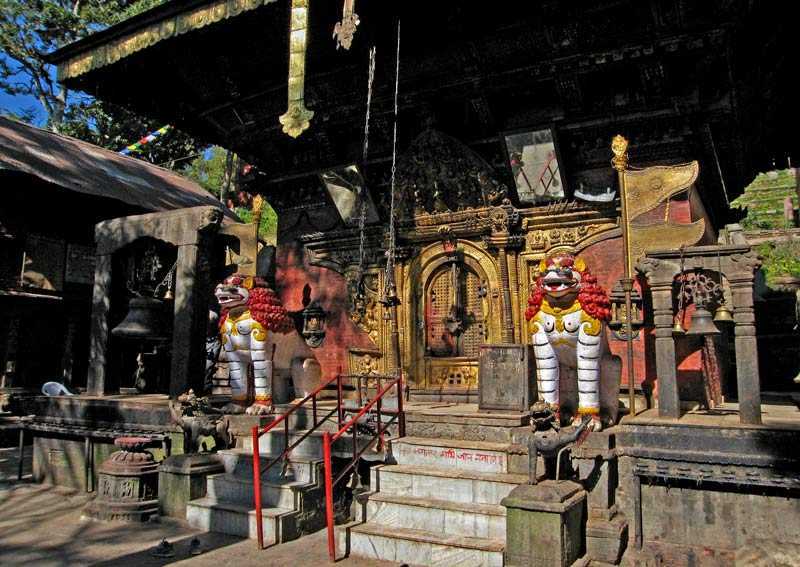Nestled in the serene outskirts of Kathmandu, the Vajrayogini Temple stands as a testament to Nepal’s rich spiritual and cultural heritage. This ancient shrine, dedicated to the revered deity Vajrayogini, offers a captivating glimpse into the mystical traditions and artistic grandeur of the Kathmandu Valley.
The Vajrayogini Temple, also known as Vajrayogini Mandir, holds a prominent place in the tapestry of Nepalese spirituality. Its origins are steeped in legend and history, tracing back to the 14th century during the Malla period. The temple is believed to have been constructed by King Pratap Malla, who was a great patron of the arts and a fervent devotee of Vajrayogini.
Vajrayogini, a manifestation of the goddess Tara, is highly venerated in Tibetan Buddhism and Hinduism. The deity symbolizes wisdom and the transcendence of worldly attachments, making the temple a significant site for both Buddhist and Hindu pilgrims. The temple’s architecture and sculptures reflect the intricate craftsmanship and spiritual fervor of the Malla era, showcasing the blend of Hindu and Buddhist influences that characterize much of Nepalese religious art.
The temple’s architecture is a marvel in itself, with its pagoda-style structure and richly adorned facades. The main sanctum of the temple houses a striking idol of Vajrayogini, which is meticulously sculpted and embellished with intricate details. The deity is depicted in a dancing pose, surrounded by a halo of flames, symbolizing the energy and vitality of the goddess.
The temple’s outer walls are adorned with elaborate carvings and frescoes that depict various deities, mythical creatures, and scenes from religious texts. These artworks are a testament to the skill and devotion of the artisans who contributed to the temple’s construction. The vibrant colors and intricate designs capture the essence of Nepalese religious art, offering a visual feast for visitors and devotees alike.
Vajrayogini Temple serves as a spiritual hub for thousands of devotees who visit the shrine to seek blessings and solace. The temple is particularly renowned for its annual festivals and rituals, which attract pilgrims from across Nepal and neighboring regions. The most significant of these is the Vajrayogini Jatra, held in the lunar month of Ashadh (June-July), which features elaborate processions, devotional chants, and offerings.
During the festival, the temple is beautifully illuminated with lamps and candles, creating a mesmerizing atmosphere that enhances the spiritual experience. Devotees gather to participate in traditional ceremonies, offer prayers, and engage in acts of charity. The Jatra also includes cultural performances, traditional dances, and music that celebrate the rich heritage of the Kathmandu Valley.
In addition to the Jatra, the temple hosts daily rituals and ceremonies conducted by a team of dedicated priests. These rituals involve the chanting of sacred mantras, the offering of incense and flowers, and the recitation of religious texts. The serene ambiance and the presence of the deity create a conducive environment for meditation and spiritual reflection.
Beyond its spiritual significance, Vajrayogini Temple is also a major cultural and touristic attraction. The temple’s location on the outskirts of Kathmandu offers visitors a tranquil escape from the bustling city life. The surrounding landscape, characterized by lush greenery and panoramic views of the valley, adds to the temple’s allure.
Tourists visiting the temple can explore the nearby trails and natural wonders, including the scenic forests and hills that offer breathtaking views of the Himalayas. The temple’s proximity to other historical and cultural sites in Kathmandu makes it an ideal destination for those interested in exploring the diverse heritage of Nepal.
Local handicrafts and souvenirs are available in the vicinity of the temple, providing visitors with an opportunity to take home a piece of Nepalese culture. Artisans sell traditional crafts, including sculptures, paintings, and textiles, which reflect the rich artistic traditions of the region.
As with many historical sites, the Vajrayogini Temple faces challenges related to preservation and maintenance. The effects of weathering, pollution, and natural wear and tear pose a threat to the temple’s structural integrity and artistic heritage. Efforts are underway to address these issues through conservation projects and restoration initiatives.
The temple’s management, in collaboration with local authorities and heritage organizations, is working to ensure that the site’s historical and cultural values are preserved for future generations. These efforts include regular maintenance, the implementation of protective measures, and the promotion of awareness about the importance of preserving cultural heritage.
Looking ahead, Vajrayogini Temple is poised to continue playing a vital role in Nepal’s spiritual and cultural landscape. The ongoing efforts to preserve and promote the temple’s heritage are expected to enhance its appeal and significance as a destination for spiritual seekers, cultural enthusiasts, and tourists.
The temple’s unique blend of artistic grandeur, spiritual depth, and cultural richness makes it a beacon of Nepal’s heritage. As more visitors and devotees experience the temple’s beauty and spiritual atmosphere, Vajrayogini Temple will undoubtedly remain a cherished symbol of Nepal’s enduring legacy.
The Vajrayogini Temple stands as a testament to the rich spiritual and cultural traditions of Nepal. Its historical significance, architectural beauty, and spiritual significance make it a captivating destination for those seeking to explore the depths of Nepalese heritage. As the temple continues to inspire and uplift those who visit, it remains a cherished gem in the heart of Kathmandu.






